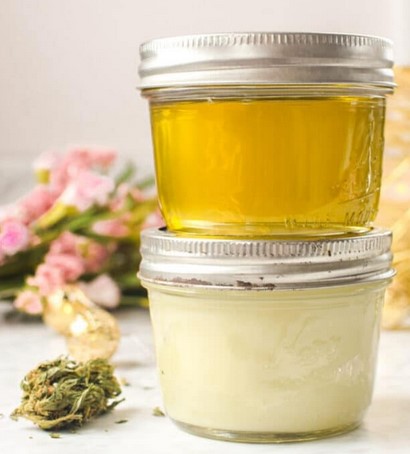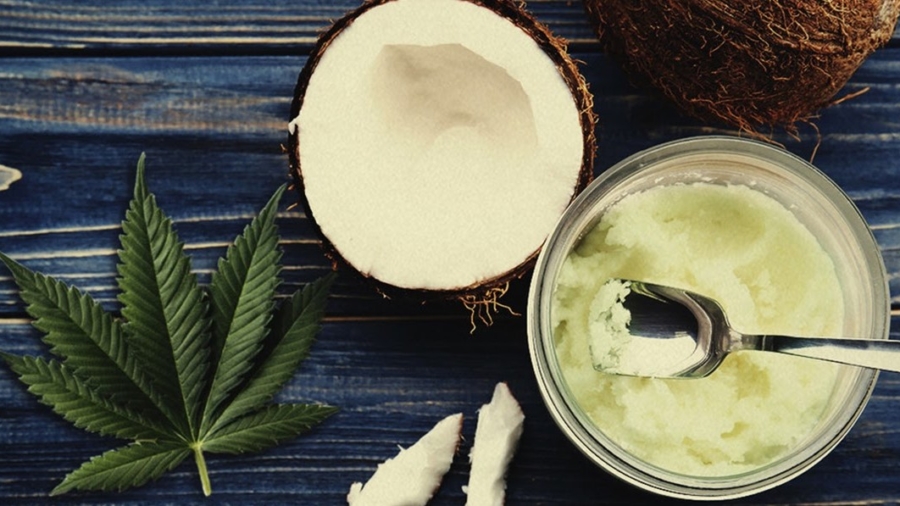Cannabis-infused coconut oil is quickly gaining popularity. But, is it more effective than butter? Why is coconut oil the best carrier fat to use with cannabis? Why is it necessary to use oil at all? Here’s why cannabis-infused coconut oil is such a healthy and powerful medicine.
Bioavailability

Compounds in cannabis are fat soluble. What does that mean, exactly? They break down in fat rather than water. This means that in order to reap the benefits of dietary cannabinoids, you’ll need to consume them with some fat. Coconut oil is superior for nutrient absorption. This is true not only for cannabis but for other fat-soluble nutrients as well. Vitamin E and beta-carotene are two examples. In fact, when you purchase nutritional supplements, opting for liposomal (fat-based) delivery systems can dramatically enhance the total amount of nutrients you actually absorb. When you combine cannabinoids with fat, the fat helps the cannabinoids travel through your digestive tract where they will eventually be broken down and released for your body to use.
Improved binding
The high saturated fat content in coconut oil provides ample binding opportunities for cannabinoids. Coconut oil contains around 90% saturated fat, which is far superior to olive oil (15%). (But, don’t worry! This fat won’t clog your arteries or put inches on your waistline. This topic is discussed in detail below.) Since cannabis is fat-soluble, the higher the quality of the carrier fat, the better the extraction will be. The abundance and purity of the fat in coconut oil gives cannabinoids like THC and CBD have plenty of material to work with. This means that infused coconut oil provides the greatest bang for your buck.
Different types of fat
Different fats come in different shapes. Coconut oil contains an abundance of saturated fats of unique quality. Specifically, coconut oil is high in medium-chain fatty acids (MCFAs). Other oils, like canola and sunflower oil, are primarily made of long-chain fatty acids (LCFAs). The body can break down the MCFAs in coconut oil much more easily than it can those of LCFAs. In fact, LCFAs require special enzyme proteins to break them down. Rather, MCFAs are directly metabolized into energy by the liver. This means that your body can burn those fats and put them to use right away. Liver metabolism makes for a stronger psychoactive experience. When consuming cannabis via an edible or infused oil, greater amounts of THC is converted to the psychoactive metabolite 11-hydroxy-THC. This makes the edible cannabis much stronger than smoked or vaporized cannabis. 11-hydroxy-THC crosses into the brain more easily than THC. Using coconut oil or other products that contain medium-chain triglycerides (MCT oils) triggers a relatively rapid release cannabinoids when compared to other oils. It also limits the fat stored on your waistline. Coconut oil gives you a quick energy boost without forcing your body to expend energy to free up the fat for use. When using other oils like canola, you’re more likely to store that oil as fat and it will take longer for your body to metabolize.
3 Benefits of coconut oil
There are a few other reasons to choose coconut oil. Not only is it a rich source of metabolism-boosting medium chain fatty acids, but some of these fats have specific health benefits, including,
1. Lauric acid
Lauric acid is a medium-chain fatty acid with antimicrobial properties. If you’re a fan of cannabis topicals, using slaves or creams with a coconut oil base provides natural protection against pathogens and infection. Lauric acid also promotes balanced cholesterol levels, making it a heart-healthy fat.
2. Caprylic acid
Caprylic acid is another MCFA with anti-microbial properties. Specifically, caprylic acid is anti-fungal. Research as early as 1949 found that this fat contained a natural fungicide, which could be beneficial for both topical and oral use. The over half-century old patent cited above found that the fat could be useful in treating mycotic infections on living organisms.
3. Vitamin E
Coconut oil contains small amounts of vitamin E, which is an antioxidant that is excellent for skin and hair. While the oil itself is not the best dietary source of the vitamin, it does help the body absorb vitamin E more readily. Including more coconut oil in your diet helps ensure that your body is making the best use out of the phytonutrients that you consume on a daily basis.
Cannabis coconut oil can serve as a cannabutter alternative and is an important staple recipe for any cannabis consumer to master alongside cannabis-infused olive oil.
Making infused cannabis coconut oil is a fairly straightforward process that uses both heat and fat to decarboxylate the cannabis flower and extract the cannabinoids from the plant.
This process extracts a full-spectrum of cannabinoids and other plant compounds from the plant.
Ingredients:
- 1 cup of ground cannabis flower (7-10 grams)
- 1 cup of coconut oil
Materials:
- Strainer or cheesecloth
- Grinder (a simple hand grinder works best; appliances like blenders and coffee grinder pulverize the cannabis, resulting in edibles with bad tasting plant material)
- Double-boiler, slow cooker, saucepan, etc.
Directions:
- Grind your cannabis. You can include the entire plant, just the flower, a little bit of both—this is all a matter of preference. Just keep in mind that anything small enough to fit through the strainer will end up in your finished product, so again, do not grind your cannabis to a fine powder.
- Combine oil and cannabis in your double-boiler, slow cooker, or saucepan and heat the two together on low or warm for a few hours. This allows for decarboxylation (activation of THC) without scorching (which destroys the active ingredients). Cooking can be done a variety of ways: in a slow cooker on low for 4-6 hours, stirring occasionally; in a double-boiler on low for at least 6 hours (8 is better), stirring occasionally; or in a simple saucepan on low for at least 2-3 hours, stirring frequently (a saucepan is most susceptible to scorching). In all cases, a small amount of water can be added to the mixture to help avoid burning.
- Note: whatever method you choose, temperature of the oil should not exceed 245°F.
- Strain and store the oil. Do not squeeze the cheesecloth; this will simply add more chlorophyll to your oil. All remaining plant material can be discarded or used in other dishes if you have the wherewithal. The oil’s shelf life is at least two months, and can be extended with refrigeration.
How to use cannabis coconut oil
Once you’ve got an infusion of coconut oil, the uses are endless!
- Combine your infused coconut oil with beeswax and aloe to make your own an infused cannabis topical
- Use your coconut oil in place of oil in a recipe of your choice to make a variety of infused dishes (try Herb Roasted Potatoes!)
- Infused coconut oil can easily be used as a lubricant in the bedroom (But be safe! Coconut oil may weaken condoms)
- Put your infused coconut oil into capsules for easy measurable dosing
- Make an infused cannabis tea latte
Expect to see coconut oil remain a staple in future cannabis infusions across the market. As major brands continue to innovate, coconut oil should thrive on the ingredient lists of more products to come.
If, however, you don’t have access to a dispensary near you or want to try a fun DIY with your own material, you can always make your own at home. Trust us, you’ll go coconuts for this stuff!

I found that CBD did nothing for me when taken internally, but I found it helpful for pain relief when I rub it into my arthritic knee. However, arnica helps as well and it’s a lot cheaper. I’m always suspicious of substances that are touted as a cure for many things.
I want to make cannabis infused coconut oil for my body. I live in chronic pain. Rubbing it on the pain site seems to help. I’m not interested in getting high, I just want pain relief. How do I make it?